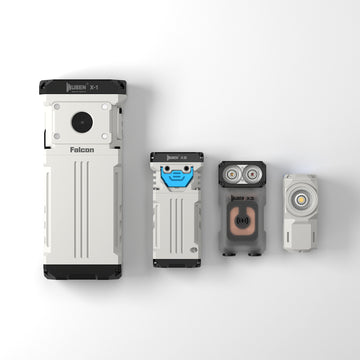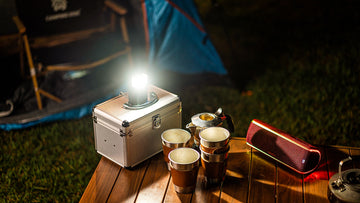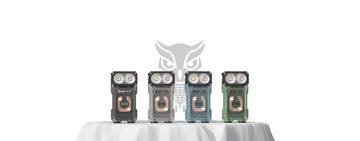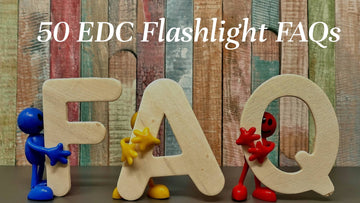
Key Takeaways
- Everyday tasks: 1-300 lumens
- Common outdoor tasks: 300-1000 lumens
- Emergency preparedness: 500-1200 lumens
- Worklight: 1000-1500 lumens
- Caving/exploration: 800-2000 lumens
- Hunting, law & military: 1200-2500 lumens
- Search & rescue: 3000+ lumens
Introduction
In the intricate realm of flashlight technology, the selection of lumens stands as a critical determinant for achieving optimal performance tailored to specific tasks. Lumens, representing the luminous flux emitted by a light source, are pivotal in illuminating diverse scenarios effectively. This comprehensive guide delves into the nuanced requirements of various applications, offering a meticulous examination of the optimal lumen ranges for each.First, what is a lumen & why is it important?
Before delving into the specific applications, it is imperative to grasp the significance of lumens. Lumens quantify the total visible light emitted by a source, providing a standardized metric for assessing flashlight brightness. A nuanced understanding of lumens ensures the precision required in selecting an appropriate flashlight for any given task.Everyday Tasks (1-300 Lumens)
For routine activities such as reading or locating items within close proximity, a modest range of 1-300 lumens suffices. This low to moderate output provides ample visibility without causing discomfort to the eyes, offering an optimal solution for an everyday carry flashlight.Common Outdoor Tasks (300-1000 Lumens)
Outdoor pursuits demand a delicate balance between brightness and practicality. In scenarios like nightly walks, runs, or camping, the 300-1000 lumen range ensures sufficient illumination for navigation while avoiding unnecessary disturbance to the environment.Emergency Preparedness (500-1200 Lumens)
In emergency situations, precision is paramount. Flashlights ranging from 500-1200 lumens strike an equilibrium between brightness and efficiency, ensuring readiness for unforeseen circumstances without compromising battery longevity.Worklight (1000-1500 Lumens)
Professionals relying on flashlights for intricate tasks, such as mechanics, necessitate a higher lumen output. The 1000-1500 lumen range caters to this requirement, offering detailed illumination within a controlled beam, promoting safety and accuracy in the workspace.Caving/Exploration (800-2000 Lumens)
Venturing into the abyss of caves demands a specialized approach. Flashlights within the 800-2000 lumen spectrum address the unique challenges of exploration, delivering a potent balance between brightness and sustained functionality to illuminate expansive and challenging environments.Hunting, Law & Military (1200-2500 Lumens)
The tactical demands of hunting, law enforcement, and military operations necessitate flashlights characterized by an intense brightness spectrum. Ranging from 1200-2500 lumens, these tools serve as powerful assets, providing not only illumination but also potential disorientation capabilities.Search & Rescue (3000+ Lumens)
At the pinnacle of brightness requirements lie search and rescue missions. A minimum of 3000 lumens is mandated to ensure comprehensive visibility in the darkest and most challenging environments. The emphasis extends beyond lumens, incorporating considerations like candela for optimal performance.Conclusion
In summary, the determination of the ideal lumen count remains a highly personalized decision. This guide serves as a tool to provide insights into the recommended and reasonable lumen ranges based on specific tasks. Yet, it’s crucial to recognize the multifaceted nature of flashlight selection, taking into account factors such as Candela, runtime, battery specifications, and more. The flashlight market offers a diverse array of options, and a thorough evaluation of these aspects ensures a well-informed decision that aligns with individual preferences and requirements.Furthermore, the versatility of a flashlight extends beyond lumens, encompassing various brightness modes. For instance, if your need is 400 lumens but you are attracted to a 1200-lumen flashlight, consider whether it features a mode that caters precisely to your requirements, such as a 400-lumen setting. This nuanced approach not only ensures optimal performance but also enhances the adaptability of the flashlight to diverse scenarios. When embarking on the journey to choose the right flashlight, it’s essential to broaden your considerations, exploring features, modes, and capabilities. Delve into our additional blog posts for valuable insights that will empower you to make enlightened decisions in the dynamic landscape of flashlight technology.
Tags:
Related Articles



